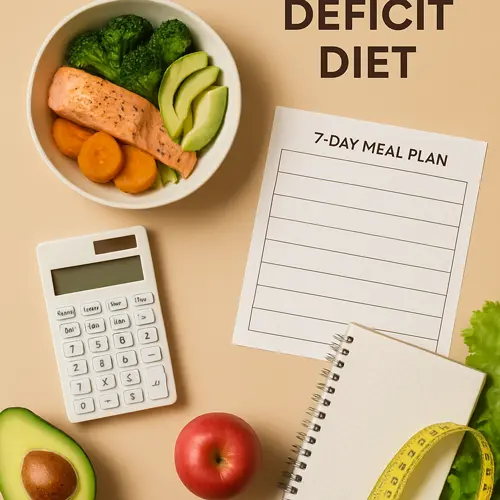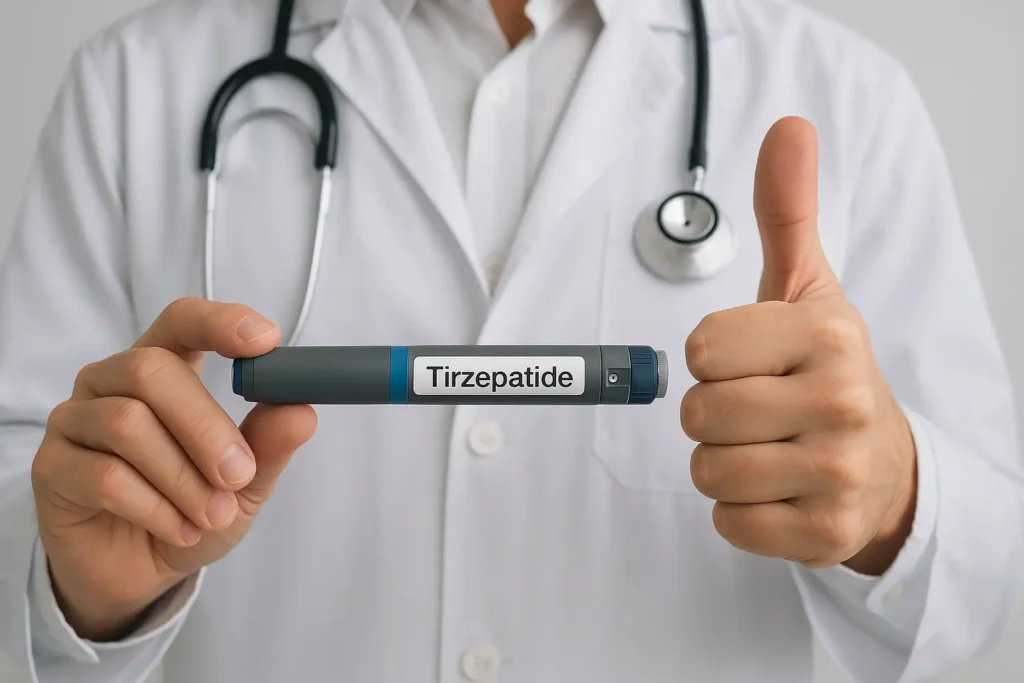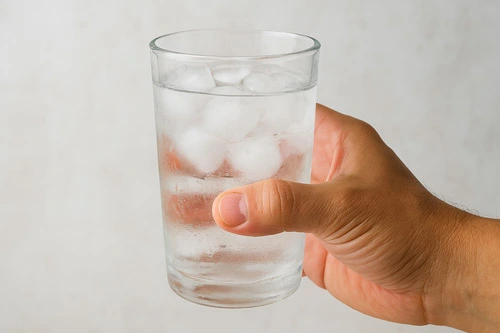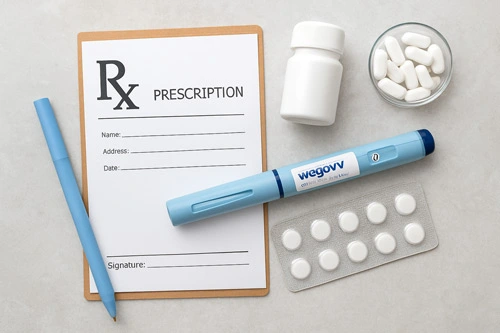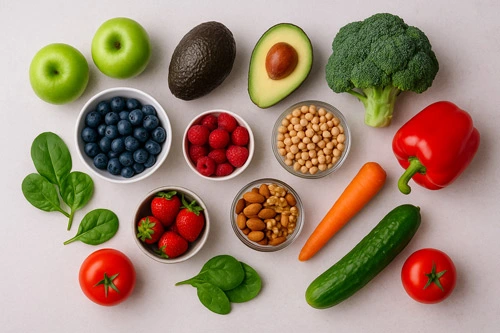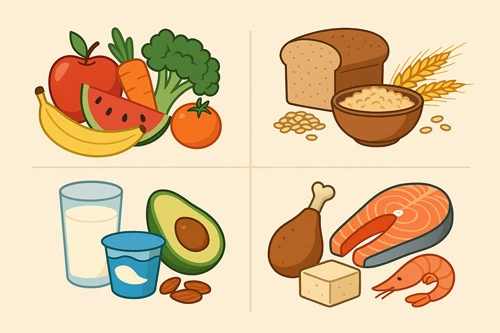Introduction: What Is a Calorie Deficit Diet?
In today’s world of ever-evolving diets and wellness trends, the calorie deficit diet remains the most scientifically proven and fundamentally sound method for sustainable weight loss. Unlike fad diets that promise rapid results through extreme restrictions or elimination of entire food groups, a calorie deficit diet focuses on one simple principle: consuming fewer calories than your body needs to maintain its current weight. This gap—known as a calorie deficit—forces your body to tap into stored fat for energy, leading to gradual and healthy fat loss over time.
At its core, a calorie deficit occurs when the number of calories you consume through food and drink is less than the number of calories your body burns for daily functions like breathing, digestion, movement, and even sleep. When consistently maintained, this deficit results in weight reduction—without necessarily requiring fancy supplements, detoxes, or intense workout regimes.
But the beauty of a calorie deficit diet lies in its flexibility. It doesn’t prescribe a one-size-fits-all plan but can be adapted to fit your personal preferences, cultural eating habits, activity levels, and health goals. Whether you’re eating Indian meals, following a vegetarian lifestyle, or looking for a plan tailored specifically for women, a calorie deficit can be customized to work for you.
In this comprehensive guide, we’ll explore exactly how a calorie deficit diet works, how to calculate your own calorie needs, what to eat (and what to avoid), and how to build a realistic, effective 7-day calorie deficit diet plan. You’ll also discover tools like free calorie deficit calculators, tips for women, meal suggestions, and the answer to a common question: how long does it really take to lose weight with a calorie deficit?
How Does a Calorie Deficit Help You Lose Weight?
When it comes to losing weight effectively, few strategies are as straightforward and science-backed as maintaining a calorie deficit. But how exactly does this process work within your body?
To begin with, your body requires a certain amount of energy (calories) to perform daily functions. This includes your Basal Metabolic Rate (BMR)—the number of calories your body needs just to survive without any physical activity. On top of that, calories are burned through regular movement, exercise, digestion, and even small unconscious movements like fidgeting. The total number of calories you burn in a day is called your Total Daily Energy Expenditure (TDEE).
A calorie deficit occurs when your calorie intake is less than your TDEE. For instance, if your body needs 2,200 calories a day to maintain its weight, but you only consume 1,700, you’re creating a 500-calorie deficit. In response to this energy shortfall, your body begins to use its stored energy—mainly in the form of body fat—to bridge the gap. Over time, this results in fat loss and eventually weight loss.
So, how long does it take to lose weight with a calorie deficit? The answer depends on several factors, including the size of your deficit, your starting weight, metabolism, age, gender, and level of physical activity. A common guideline is that a daily deficit of 500 calories will lead to about one pound (0.45 kg) of weight loss per week, since one pound of fat equals roughly 3,500 calories.
However, weight loss isn’t always linear. You may experience fluctuations due to water retention, hormonal changes, or muscle gain (if you’re strength training). But the key is consistency—if you maintain a controlled and sustainable calorie deficit over time, your body will gradually shed excess fat.
In summary, a calorie deficit is the essential driver behind weight loss. Whether you’re following a low-carb plan, intermittent fasting, or just watching your portions, calorie deficit is the common denominator. Understanding this concept is the first step toward creating a diet that not only helps you lose weight but also keeps it off for good.
learn more: 75 Hard Diet Workout Plan and Free PDF Guide
Who Is This 7-Day Calorie Deficit Diet Plan For?
This flexible plan is designed for:
-
Women aiming for fat loss (1,400–1,600 kcal/day)
-
Men or active individuals (1,700–1,900 kcal/day)
-
Vegetarians or Indian diet followers
-
People looking for a free, easy-to-follow diet plan
Note: You can adjust portion sizes or swap ingredients to suit your calorie goals and preferences.
📅 Day 1: High-Protein Start (International Style)
Calories: ~1500 kcal
-
🥣 Breakfast: Scrambled eggs (2), whole grain toast, avocado slices (1/2)
-
🥗 Lunch: Grilled chicken breast, quinoa salad with veggies
-
🍎 Snack: Greek yogurt (plain), 5 almonds
-
🍲 Dinner: Baked salmon, steamed broccoli, sweet potato
📅 Day 2: Vegetarian Indian-Style Plan
Calories: ~1450 kcal
-
🍽️ Breakfast: Poha with peas, 1 boiled egg (optional)
-
🍛 Lunch: Dal tadka, 1 cup brown rice, cucumber salad
-
🥛 Snack: Buttermilk or low-fat lassi
-
🍜 Dinner: Mixed vegetable sabzi, 1 multigrain roti, sautéed spinach
📅 Day 3: Low-Carb & Fiber-Focused
Calories: ~1550 kcal
-
🍳 Breakfast: 2 boiled eggs, sautéed mushrooms, black coffee
-
🥗 Lunch: Tuna lettuce wraps, boiled egg
-
🍫 Snack: Protein bar or low-sugar dark chocolate
-
🍲 Dinner: Grilled tofu or paneer tikka, mixed greens salad
📅 Day 4: Calorie Deficit Meals for Women (Hormone-Friendly)
Calories: ~1400–1500 kcal
-
🥣 Breakfast: Overnight oats with chia seeds and berries
-
🥬 Lunch: Chickpea salad with olive oil dressing
-
🥤 Snack: Low-fat milkshake (banana + protein powder)
-
🍛 Dinner: Grilled tofu, sautéed zucchini, brown rice (1/2 cup)
📅 Day 5: Indian Calorie Deficit Plan (South-Asian Inspired)
Calories: ~1500 kcal
-
🍽️ Breakfast: Moong dal chilla (2) with mint chutney
-
🍛 Lunch: Sambar, 1 cup cooked rice, cabbage poriyal
-
🍵 Snack: Masala tea (no sugar), handful of roasted chana
-
🍲 Dinner: Vegetable upma with curd
📅 Day 6: Simple International-Style Deficit Diet
Calories: ~1600 kcal
-
🥚 Breakfast: 3 egg whites, 1 slice whole grain toast
-
🥗 Lunch: Chicken Caesar salad (light dressing)
-
🥜 Snack: Apple + 1 tbsp peanut butter
-
🍝 Dinner: Whole-wheat pasta (small portion), tomato basil sauce, grilled vegetables
📅 Day 7: Low-Calorie Vegetarian Plan
Calories: ~1450 kcal
-
🥣 Breakfast: Fruit smoothie with low-fat yogurt
-
🥬 Lunch: Rajma (kidney bean curry), 1 cup rice, side salad
-
🥤 Snack: Coconut water + roasted seeds
-
🥘 Dinner: Vegetable khichdi, curd, cucumber raita
🟨 Additional Notes:
-
This plan is a free calorie deficit diet plan, easy to follow at home.
-
You can use a calorie deficit calculator to personalize daily targets.
-
Adjust quantities based on your TDEE and lifestyle.
-
All meals are balanced and nutrient-dense to support metabolism and satiety.
- learn more: Animal-Based Diet: Full Guide, Food List, Meal Plan & Benefits
What to Eat in a Calorie Deficit? (Best Foods for Fat Loss)
One of the most common questions people ask when starting a calorie deficit diet is: “What should I actually eat?” The answer isn’t just about eating less—it’s about eating smart. To succeed in a calorie deficit without feeling constantly hungry or deprived, you need foods that are nutrient-dense, low in calories, and high in volume or satiety.
Below, we’ll explore the best food categories to include in your calorie deficit meals, explain why they’re effective for weight loss, and offer practical examples for everyday use.
🥬 1. High-Volume, Low-Calorie Vegetables
Vegetables are the cornerstone of a smart calorie deficit diet plan. They are naturally low in calories but high in fiber, vitamins, minerals, and water content—making them perfect for bulk without excess calories.
Top choices:
-
Leafy greens (spinach, kale, arugula)
-
Cruciferous vegetables (broccoli, cauliflower, cabbage)
-
Zucchini, mushrooms, cucumbers, bell peppers
-
Pumpkin, squash, tomatoes
Why they work:
They help you feel full without adding many calories, especially when eaten raw, grilled, or steamed with minimal oil.
🍗 2. Lean Proteins
Protein is essential in a calorie deficit diet for preserving muscle mass, boosting metabolism, and reducing hunger. It also has the highest thermic effect, meaning your body burns more calories digesting protein than it does carbs or fats.
Best options:
-
Chicken breast, turkey, lean beef
-
Fish (salmon, cod, tuna)
-
Eggs and egg whites
-
Greek yogurt, cottage cheese
-
Plant-based proteins: tofu, tempeh, lentils, chickpeas
Pro tip:
Include a source of protein in every meal to feel satisfied longer and prevent muscle loss.
🥣 3. Whole Grains (in Moderation)
Whole grains provide slow-digesting carbohydrates, fiber, and B vitamins, which help sustain energy throughout the day. While they are more calorie-dense than veggies, they offer important nutrition and can be part of a balanced calorie deficit meal.
Examples:
-
Brown rice
-
Quinoa
-
Whole oats
-
Barley
-
Whole grain bread or pasta
Tip: Stick to small portions (½ cup cooked) to manage calorie intake.
🍓 4. Fruits: Nature’s Sweet Treats
Many people mistakenly avoid fruit when trying to lose weight, but fruits are packed with fiber, antioxidants, and natural hydration. They also satisfy sugar cravings in a healthy way.
Great picks:
-
Berries (strawberries, blueberries, raspberries)
-
Apples and pears
-
Citrus fruits (oranges, grapefruit)
-
Melons (watermelon, cantaloupe)
Watch out:
While fruits are healthy, fruit juices and dried fruits are high in concentrated sugars and calories—opt for whole fruits instead.
🥑 5. Healthy Fats (in Controlled Portions)
Even in a calorie deficit, healthy fats are important for hormone function, brain health, and satiety. The key is portion control, as fats are calorie-dense (9 kcal per gram).
Good sources:
-
Avocado
-
Nuts and seeds (chia, flax, almonds, walnuts)
-
Olive oil, coconut oil
-
Fatty fish (salmon, mackerel)
Tip: Measure your fats. For example, 1 tablespoon of olive oil = ~120 kcal.
🥤 6. Smart Snacks & Low-Calorie Beverages
Snacking can be part of a calorie deficit diet—as long as you choose wisely. Avoid processed, high-calorie options and opt for nutrient-dense alternatives.
Smart snacks:
-
Low-fat Greek yogurt
-
Air-popped popcorn (no butter)
-
Boiled eggs
-
Hummus with veggie sticks
-
Protein shakes (unsweetened)
Low-calorie drinks:
-
Water (add lemon, cucumber, or mint for flavor)
-
Green tea or black coffee (no sugar)
-
Herbal teas
🧠 7. What NOT to Eat in a Calorie Deficit
To make your calorie deficit sustainable, avoid the foods that make it harder to control your appetite or cause blood sugar spikes.
🚫 Limit:
-
Sugary beverages (soda, fruit juice, energy drinks)
-
Deep-fried foods
-
White bread, pastries, and refined carbs
-
Processed snacks (chips, cookies, candy bars)
-
Alcohol (adds calories, affects metabolism and hunger)
✅ Summary: Build Every Meal Around These 3 Pillars
-
Protein: Chicken, tofu, fish, legumes
-
Fiber-Rich Carbs: Vegetables, whole grains, fruits
-
Healthy Fats (small amounts): Nuts, olive oil, seeds
With this balanced structure, your calorie deficit diet meals will help control hunger, maintain energy, and maximize fat loss.
learn more : GOLO Diet: Complete Guide to Meal Plans, Side Effects, Reviews, and Recipes
What Is a Calorie Deficit Diet? [calorie deficit diet meaning]
A calorie deficit diet refers to a nutritional approach where the number of calories you consume is less than the number of calories your body burns in a day. This gap between calorie intake and calorie expenditure is what leads to weight loss. The concept is rooted in basic energy balance: when your body is in a deficit, it turns to stored fat for energy, resulting in fat loss over time.
To understand the calorie deficit diet meaning, imagine your body as a bank account. If you spend more money (burn more calories) than you deposit (consume), your balance decreases. Similarly, if your body burns more calories than it takes in, you lose weight.
This strategy is not about starving or extreme dieting. Rather, it’s about making smarter food choices and adjusting portion sizes so that you’re eating fewer calories than your body needs for maintenance. A well-planned calorie deficit diet plan can include nourishing foods that fuel your body while still creating that essential deficit.
A calorie deficit diet for weight loss is one of the most researched and recommended approaches by dietitians and health professionals worldwide. It provides a sustainable path to losing fat while preserving lean muscle, especially when paired with strength training and adequate protein intake.
You can calculate your personal calorie deficit with a calorie deficit calculator, which helps determine how many calories you need to eat per day to lose a specific amount of weight safely.
In the next section, we’ll explore exactly how to calculate your ideal calorie deficit, and how much of a deficit is needed to achieve noticeable results.
How to Calculate Your Calorie Deficit
[Calorie deficit calculator | Calorie deficit to lose weight calculator]
To create a calorie deficit diet plan, you first need to determine how many calories your body burns in a day. This is known as your Total Daily Energy Expenditure (TDEE). Your TDEE depends on several factors including:
-
Basal Metabolic Rate (BMR) – the number of calories your body uses at rest for essential functions like breathing and digestion
-
Physical activity level – how active you are throughout the day
-
Age, gender, weight, and height
Step 1: Calculate Your BMR
You can use the Mifflin-St Jeor Equation to estimate your BMR:
-
For men:
BMR = (10 × weight in kg) + (6.25 × height in cm) − (5 × age in years) + 5 -
For women:
BMR = (10 × weight in kg) + (6.25 × height in cm) − (5 × age in years) − 161
Step 2: Multiply BMR by Activity Factor
Use an activity multiplier to find your TDEE:
| Activity Level | Multiplier |
|---|---|
| Sedentary (little or no exercise) | 1.2 |
| Lightly active (1-3 days/week) | 1.375 |
| Moderately active (3-5 days/week) | 1.55 |
| Very active (6-7 days/week) | 1.725 |
| Extra active (twice a day workouts) | 1.9 |
TDEE = BMR × Activity Level Multiplier
Step 3: Create a Calorie Deficit
To lose weight, you need to eat fewer calories than your TDEE. A healthy deficit is usually 500 to 1000 calories per day, which leads to 0.5–1 kg (1–2 pounds) of fat loss per week.
For example, if your TDEE is 2,200 calories, eating 1,700 calories per day will create a 500-calorie deficit.
You can use a free calorie deficit calculator online by entering your age, gender, weight, height, and activity level. These tools can also tell you how long it will take to lose a certain amount of weight using your target calorie deficit to lose weight calculator.
7-Day Calorie Deficit Diet Plan
[calorie deficit diet plan | 7-day calorie deficit diet plan]
A structured 7-day calorie deficit diet plan helps you stay consistent, make better food choices, and maintain a sustainable eating pattern for weight loss. Here’s a sample weekly meal plan based on a 1,500-calorie/day average, which suits many individuals aiming for a moderate calorie deficit.
Note: Adjust portion sizes according to your personal TDEE and calorie goals.
Day 1
-
Breakfast: Greek yogurt with berries and chia seeds
-
Snack: A small apple with 1 tbsp peanut butter
-
Lunch: Grilled chicken salad with olive oil and lemon dressing
-
Snack: 10 almonds
-
Dinner: Baked salmon with steamed broccoli and quinoa
Day 2
-
Breakfast: Oatmeal with banana slices and cinnamon
-
Snack: Low-fat string cheese
-
Lunch: Turkey sandwich on whole grain bread + mixed greens
-
Snack: Cucumber and carrot sticks with hummus
-
Dinner: Stir-fried tofu with vegetables and brown rice
Day 3
-
Breakfast: Scrambled eggs with spinach and tomatoes
-
Snack: A pear
-
Lunch: Grilled shrimp over arugula and avocado
-
Snack: 1 boiled egg
-
Dinner: Chicken breast with sweet potato and green beans
Day 4
-
Breakfast: Smoothie with protein powder, almond milk, spinach, and strawberries
-
Snack: ½ cup cottage cheese
-
Lunch: Quinoa bowl with beans, corn, and bell peppers
-
Snack: Celery with light cream cheese
-
Dinner: Turkey meatballs with spaghetti squash and tomato sauce
Day 5
-
Breakfast: Whole grain toast with avocado and poached egg
-
Snack: 1 orange
-
Lunch: Grilled tuna with kale salad and vinaigrette
-
Snack: Greek yogurt
-
Dinner: Vegetable soup with a side of roasted chickpeas
Day 6
-
Breakfast: Chia pudding with almond milk and blueberries
-
Snack: 10 pistachios
-
Lunch: Chicken wrap with lettuce, tomato, and mustard
-
Snack: Handful of grapes
-
Dinner: Grilled cod with asparagus and brown rice
Day 7
-
Breakfast: Protein pancakes with fresh raspberries
-
Snack: 1 banana
-
Lunch: Lentil salad with cherry tomatoes and parsley
-
Snack: Low-fat milk or soy milk
-
Dinner: Veggie-stuffed bell peppers with ground turkey
This 7-day calorie deficit diet plan is designed to keep your meals nutritious, varied, and satisfying while keeping you in a calorie deficit for weight loss. You can repeat and rotate the meals weekly or create your own personalized menu using the same calorie principles.
Calorie Deficit and Exercise: How They Work Together
Combining a calorie deficit diet with regular exercise can significantly enhance your weight loss results and improve overall health. While a calorie deficit alone leads to fat loss, adding physical activity helps preserve lean muscle mass, boost metabolism, and improve cardiovascular fitness.
Why Exercise Matters During a Calorie Deficit
When you eat fewer calories than your body needs, there’s a risk of losing muscle along with fat. Resistance training (like weightlifting) signals your body to maintain muscle tissue, preventing muscle loss and promoting a leaner physique.
Exercise also increases your Total Daily Energy Expenditure (TDEE), allowing you to create a larger calorie deficit without feeling overly restricted in your food intake. For example, a 30-minute brisk walk can burn around 150 calories, which can be added to your deficit for faster weight loss or compensated by slightly increasing your calorie intake to support energy levels.
Types of Exercise to Include
-
Strength training: Builds and preserves muscle mass; recommended 2-4 times per week.
-
Cardiovascular exercise: Burns calories and improves heart health; activities like walking, cycling, swimming.
-
Flexibility and balance exercises: Yoga, Pilates, stretching to enhance recovery and prevent injury.
Listening to Your Body
During a calorie deficit, energy levels might be lower, so it’s important to adjust workout intensity and rest days accordingly. Staying hydrated and fueling your workouts with nutrient-dense meals helps maintain performance.
Common Challenges in a Calorie Deficit Diet and How to Overcome Them
Following a calorie deficit diet can sometimes be challenging. Understanding common obstacles and having strategies to overcome them can greatly improve your chances of success and make the journey smoother.
1. Hunger and Cravings
One of the biggest challenges is managing hunger and cravings, especially in the early stages. Eating high-protein, high-fiber foods helps increase satiety. Drinking plenty of water and spacing meals evenly throughout the day can also reduce hunger pangs.
Tips:
-
Include protein in every meal
-
Snack on veggies or nuts if needed
-
Avoid skipping meals to prevent overeating later
2. Plateaus and Slow Progress
Weight loss may stall after some time due to metabolic adaptations or water retention. This is normal and requires patience.
Solutions:
-
Recalculate your calorie needs using a calorie deficit calculator
-
Slightly adjust calorie intake or increase activity level
-
Focus on non-scale victories like improved fitness or energy
3. Social Events and Eating Out
Dining out or social gatherings often involve calorie-dense foods which can disrupt your deficit.
Tips:
-
Plan ahead by checking menus online
-
Choose grilled or steamed options
-
Practice portion control and mindful eating
4. Lack of Motivation
Staying motivated for long-term weight loss can be tough.
Suggestions:
-
Set realistic, measurable goals
-
Track progress with photos or measurements
-
Find a support system or accountability partner
Calorie Deficit Diet for Women: Special Considerations
Women often face unique challenges and considerations when following a calorie deficit diet for weight loss. Hormonal fluctuations, metabolic differences, and lifestyle factors can influence how women respond to calorie deficits and affect their weight loss journey.
Hormonal Influences
Women’s hormones, such as estrogen and progesterone, fluctuate throughout the menstrual cycle, affecting appetite, energy levels, and water retention. For example, some women experience increased hunger and cravings during the luteal phase (after ovulation), which can make maintaining a calorie deficit more challenging.
Tip: Track your cycle and adjust calorie intake or food choices accordingly to stay on track without feeling deprived.
Avoiding Excessive Calorie Restriction
Severe calorie restriction can disrupt hormonal balance, leading to irregular periods, fatigue, and loss of bone density. Women should aim for a moderate calorie deficit that supports fat loss while maintaining overall health.
Prioritize Nutrient Density
Women often have higher needs for certain nutrients like iron, calcium, and folate. A calorie deficit diet for women should emphasize nutrient-rich foods like leafy greens, lean proteins, dairy or fortified alternatives, and whole grains.
Strength Training and Muscle Preservation
Maintaining muscle mass is crucial, especially for women, to keep metabolism high. Including resistance exercises in your routine helps preserve lean tissue during weight loss.
Practical Meal Ideas
Incorporate satisfying, hormone-friendly meals such as:
-
Greek yogurt with berries and flaxseed
-
Lentil soup with vegetables
-
Grilled chicken salad with avocado
-
Oatmeal with nuts and fruit
Free Calorie Deficit Diet Plan & Useful Tools
Starting a calorie deficit diet plan can feel overwhelming, but thankfully, there are many free resources and tools available to simplify the process and help you stay on track.
Free Calorie Deficit Diet Plan Templates
Several websites and apps offer downloadable or interactive calorie deficit diet plan free templates tailored to different calorie goals and dietary preferences. These plans provide balanced meal ideas, shopping lists, and portion sizes to guide you.
Calorie Deficit Calculators
Using a calorie deficit calculator or a calorie deficit to lose weight calculator helps you personalize your daily calorie goals based on your age, weight, height, gender, and activity level. Many calculators also estimate how long it will take to reach your weight loss target based on your chosen deficit.
Popular tools include:
-
MyFitnessPal
-
Cronometer
-
Lose It!
-
Fitbit’s calorie calculator
Apps for Tracking Meals and Activity
Logging your food intake and exercise improves accountability and helps maintain an accurate calorie deficit. Most calorie calculators integrate with mobile apps for easy tracking.
Tips for Using Free Plans and Tools Effectively
-
Be honest and consistent with your tracking
-
Adjust your calorie targets as you lose weight
-
Use meal reminders and notifications
-
Combine tools with expert advice when possible
Using these resources makes it easier to create a sustainable, flexible, and effective calorie deficit diet plan free of guesswork.
How Long to Lose Weight on a Calorie Deficit Diet?
[calorie deficit how long to lose weight]
Many people wonder: “How long will it take to see results on a calorie deficit diet?” The answer depends on several factors including your daily calorie deficit, starting weight, metabolism, age, gender, and adherence to the plan.
Typical Weight Loss Rates
A safe and sustainable rate of weight loss is generally 0.5 to 1 kilogram (1 to 2 pounds) per week. This corresponds to a daily calorie deficit of about 500 to 1000 calories.
-
For example, a 500-calorie daily deficit leads to roughly 1 pound of fat loss per week.
-
Larger deficits may lead to faster weight loss but can increase muscle loss and are harder to maintain.
Factors Affecting Weight Loss Duration
-
Starting weight: Heavier individuals often lose weight faster initially.
-
Metabolic adaptations: As you lose weight, your metabolism may slow, reducing your calorie needs.
-
Exercise habits: Physical activity can speed fat loss and help preserve muscle.
-
Diet adherence: Consistency is key for lasting results.
What to Expect Over Time
-
The first 1-2 weeks might show rapid loss due to water weight.
-
After that, fat loss tends to be steady but slower.
-
Plateaus are normal; reassessing calorie needs and increasing activity can help overcome them.
Long-Term Success
Remember, a calorie deficit diet is not a quick fix but a lifestyle change. Sustainable weight loss comes from consistent effort over months, not days.
Final Thoughts: Is a Calorie Deficit Diet Right for You?
A calorie deficit diet remains the gold standard for safe, effective, and sustainable weight loss. By simply consuming fewer calories than your body needs, you harness your body’s natural ability to burn stored fat and improve your health.
This approach is flexible, customizable, and supported by science—whether you prefer a 7-day calorie deficit diet plan, are looking for calorie deficit diet meals that fit your taste and lifestyle, or want to use helpful tools like a calorie deficit calculator to track your progress.
Remember, the key to success is consistency, patience, and choosing nutrient-dense foods that keep you full and energized. For women, paying attention to hormonal cycles and nutrient needs enhances results without compromising health.
If you’re ready to commit to a balanced calorie deficit diet plan for weight loss, start by calculating your calorie needs, setting a realistic deficit, and building your meals around whole foods and lean proteins. Utilize free resources and track your journey to stay motivated.
Ultimately, the best diet is one you can maintain long term — and a calorie deficit diet offers exactly that: a practical, science-backed way to reach your weight loss goals and sustain a healthy lifestyle.

